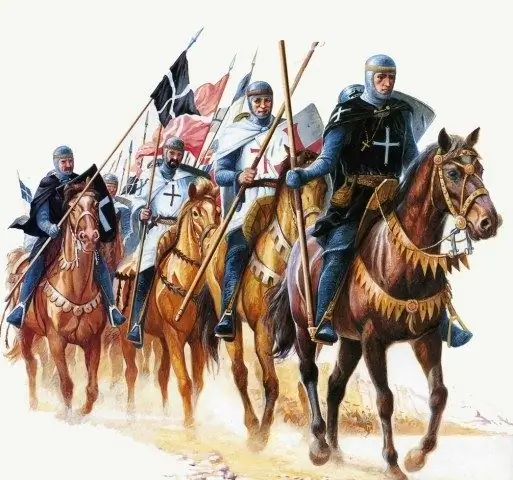- Author Antonio Harrison [email protected].
- Public 2023-12-16 07:44.
- Last modified 2025-01-22 21:44.
What associations immediately arise with the words "knight", "chivalry"? Someone will immediately remember a good, albeit not quite accurate from a historical point of view, S. Eisenstein's film "Alexander Nevsky" with his knight-dogs. Someone will have associations with a noble, cultured person who behaves impeccably in society and is especially gallant with ladies.

How did the word "knight" come about?
Chivalry as an estate played a big role in the life of many countries and for a long time was the main military force deciding the outcome of battles.
The term "knight" itself has Germanic roots. The word "ritter" in translation from German means "rider". Thus, the main meaning of this term is an equestrian warrior. Since ancient times, cavalry has played a huge role in military affairs. Horse detachments conducted reconnaissance, made long-distance raids behind enemy lines, attacked his foragers. But the main thing is that they could decide the outcome of the battle, since the cavalry has tremendous penetrating power. Therefore, the presence of combat-ready cavalry in each state was given a very large role.
Not every man fit for military affairs could go on a campaign on a horse. After all, the maintenance of a war horse cost a lot of money, and learning to ride and attack in close formation required a lot of time and effort. This was available only to fairly wealthy people. So gradually in many states, including Ancient Rome, a special class arose - "horsemen". In wartime, it was obliged to send a certain number of cavalrymen to the service, equipping them and supplying them with everything necessary.
It was the class of horsemen with the beginning of the Middle Ages that became the prototype of the knightly. Gradually, as technology developed, the weapons and armor of the knights became more and more powerful, light chain mail with overhead plates replaced the shells that cover almost the entire body. A full set of armor could weigh about 40-45 kilograms. Horses were also often protected by armor covering the front of the body. An attack from a close formation of such heavily armed horsemen could break through any defenses of the infantry, even the brave and well trained. And only with the advent of firearms, the knightly cavalry gradually began to lose its importance.
Who could become a knight
Only a man of noble birth could belong to the knightly estate. He was knighted either for accomplishing a feat, or for conscientious and diligent service. During the ceremony, the future knight knelt down, and the initiator (as a rule, his overlord) inflicted a symbolic blow on the shoulder with a drawn sword. After that, the knight received the right to wear an ornate belt and gold spurs. He had to unswervingly follow the code of knightly honor, although in reality this did not always happen.






